Stuff
I had so much fun at DeSoto on the Spring IPT that I have decided to run a (short-notice) Spring Sandbar Secrets DeSoto IPT: May 5-through the morning session on May 8, 2019 (3 1/2 days). Scroll down for details. I will go with one participant … Airport pick-up, riding with the leader, and sharing an AirBNB are all possibilities. DeSoto IPT participants Luis Alberto Grunauer joined my for a free ILE session on Monday morning and Chuck Murphy did the same on Tuesday morning. He is still photographing the crane colts as I top at 9:07am.
Of note is the fact that I never once using my Nikon 600mm f/4 VR lens on the first DeSoto IPT … Any questions on how that happened?
|
|
|
From left to right, Luis, Anita North, Tony Zielinski, yours truly (in the orange watch cap), Chuck, Dan Tishman, Spears McAllester, and Randy Strickland. The Fort DeSoto Spring IPT Happy Campers GroupImage thanks to some guy on the beach using Chuck Murphy’s iPhone |
The Fort DeSoto Spring IPT Happy Campers Group
Despite two northwest wind-against-sun mornings and an afternoon of rain and thunderstorms, everyone on the DeSoto IPT went home happy and smarter with at least a few very good if not great images.
BIRDS AS ART
BIRDS AS ART is registered in the U.S. Patent and Trademark Office.
Selling Your Used Photo Gear Through BIRDS AS ART
Selling your used (or like-new) photo gear through the BAA Blog is a great idea. We charge only a 5% commission. One of the more popular used gear for sale sites charged a minimum of 20%. Plus assorted fees! Yikes. They went out of business. And e-Bay fees are now up to 13%. The minimum item price here is $500 (or less for a $25 fee). If you are interested please scroll down here or shoot us an e-mail with the words Items for Sale Info Request cut and pasted into the Subject line :). Stuff that is priced fairly — I offer pricing advice to those who agree to the terms — usually sells in no time flat. Over the past year, we have sold many dozens of items. Do know that prices on some items like the EOS-1D Mark IV, the old Canon 100-400, the old 500mm, the EOS-7D and 7D Mark II and the original 400mm DO lens have been dropping steadily. You can always see the current listings by clicking on the Used Photo Gear tab on the orange-yellow menu bar near the top of each blog post page.
Note: all BAA Used Gear sales include insured ground shipping via UPS to lower 48 US addresses only.
Canon EF 500mm f/4 L IS Lens (the original IS model) plus extras!
Joel Eade is offering a Canon EF 500mm f/4 L IS (the original IS model, the “old five”) in excellent condition for the BAA record-low price of $2999.00. The lens has been covered with a LensCoat (included) since day one. Also included is the rear lens cap, the lens trunk, the original tough front lens cover, the original lens foot, and insured ground shipping via UPS to lower 48 US addresses only. Your item will not ship until your check clears.
Please contact Joel via e-mail.
The 500mm f/4 lenses have been the world’s most popular telephoto lenses for birds, nature, wildlife, and sports for many decades. I owned and used and loved my “old five” for many years. If you don’t have the cash for a 500 II and can handle the additional 1 1/2 pounds, then this is your best super-telephoto option. Most everyone can produce sharp images with this lens and a 1.4X TC. Folks with good to excellent sharpness techniques can do the same with a 2X TC. With the new 500 II selling for $8,999 you can save a bundle by grabbing Joel’s lens right now.
Canon EOS 5D Mark III Body with extras!
Price Reduced $120.00 on April 21, 2019.
Dick Bernard is also offering a Canon Canon EOS 5D Mark III body in near-mint condition but for a small whitish scrape mark on the bottom rear of the camera for the great low price of $879.00 (was $999.00). The sale includes the front body cap, the original product box, the strap, the cables, the Canon EOS digital software instruction manual, three (3) 64 GB UDMA7 1000x Compact flash cards, three (3) third party batteries, the charger, and and insured ground shipping via major courier to lower 48 US addresses only. Your item will not ship until your check clears unless other arrangements are made.
Please contact Dick via e-mail.
I owned and used this superb, full frame, 22mp digital body for several years. It was always my first choice for scenic, Urbex (urban exploration), and flower photography until I fell in love for a while with the 5DS R (for a lot more money!). Then I switched to the 5D IV body. In addition, I loved my 5D III body for birds with my big lenses and both TCs. I used mine to create many dozens of high quality images. Then I switched to Nikon. John’s body can be yours for a bargain price. artie
|
|
|
Fort DeSoto in spring is rife with tame birds, many in full breeding plumage. Click on the composite to enjoy a larger version. Clockwise from upper left around to center: Laughing Gull landing on head of Brown Pelican, Laughing Gull in flight, Reddish Egret sunrise silhouette, Great Blue Heron with needlefish, Yellow-crowned Night Heron with ghost crab, Roseate Spoonbill, Sanderling in breeding plumage, and white morph Reddish Egret in glorious breeding plumage. |
The 2019 Fort DeSoto Short-Notice Sandbar Secrets IPT/Sunday May 5 through the morning session on Wednesday May 8, 2019: 3 1/2 DAYS: $1649. Limit 4/Openings: 4. Meet and greet at 7PM on the evening of Saturday May 4.
I will run this with a single registrant. Airport pick-up might be available as is riding with the leader. Combine those to avoid having to rent a car.
Fort DeSoto, located just south of St. Petersburg, FL, is a mecca for a great variety of migrant shorebirds, gulls, terns, and passerines in Spring. Many of the gulls and terns will be courting and copulating. There the migrants join hundreds of Florida resident egrets, herons, night-herons, and pelicans on the T-shaped peninsula. We should get to photograph one of Florida’s most desirable shorebird species: Marbled Godwit. Black-bellied Plover and Willet are easy, American Oystercatcher almost guaranteed. Great Egret, Snowy Egret, Great Blue Heron, Tricolored Heron, and White Ibis are easy as well and many of those will be in their spectacular breeding plumages. Yellow-crowned Night-Heron is a strong possibility. We may get to see and photograph the amazing heron/egret hybrid that has been present for three years. And we should enjoy some great Brown Pelican flight photography. In addition, Royal, Sandwich, Forster’s, and Caspian Terns will likely provide us with some good flight opportunities as well. Though not guaranteed, Roseate Spoonbill and Wood Stork might well be expected. And we will be on the lookout for a migrant passerine fallout in the event of a thunderstorm or two. Yikes, I almost forgot to mention that nearly all of the birds are ridiculously tame!
|
|
|
Yes, Fort DeSoto in spring is rife with tame birds, most in breeding plumage. Click on the composite to enjoy a larger version. Clockwise from upper left around to center: breeding plumage Dunlin, dark morph Reddish Egret displaying, Laughing Gull vertical front-end portrait, Laughing Gull with prey item, landing on head of Brown Pelican, breeding plumage Royal Tern displaying, Royal Terns — pre-copulatory stance, Laughing Gulls copulating, Laughing Gull head portrait, breeding plumage Sandwich Tern with fish, and a rare treat, a breeding plumage White-rumped Sandpiper. |
Just some of the stuff you will learn …
On the IPT you will learn basics and fine points of digital exposure and to get the right exposure every time after making a single test exposure, how to approach free and wild birds without disturbing them, to understand and predict bird behavior, to identify many species of shorebirds, to spot the good situations, to choose the best perspective, to see and understand the light, and to design pleasing images by mastering your camera’s AF system. Most importantly you will surely learn to evaluate wind and sky conditions and understand how they affect bird photography. And you will learn how and why to work in Manual mode (even if you’re scared of it).
|
|
|
Again, Fort DeSoto in spring is rife with tame birds, most in breeding plumage. Click on the composite to enjoy a larger version. Clockwise from upper left around to center: Laughing Gull in flight, Yellow-crowned Night-Heron, Sandwich Terns copulating, Roseate Spoonbill, Great Egret with reflection, breeding plumage Short-billed Dowitcher, American Oystercatcher, Royal Tern, white morph Reddish Egret, and Snowy Egret in marsh. |
What we do
There will be seven shooting sessions in all: four 3+ hours morning session and three 2 1/2 hour afternoon sessions. There will be Photoshop/image review/critiquing sessions during lunch (lunch is included) on each of the three full days. That will be followed by Instructor Nap Time.
The best airport is Tampa (TPA). Once you register, you will receive an e-mail with the hotel/lodging information. Airport pick-up might be available as is riding with the leader. Combine those to avoid having to rent a car.
|
|
|
You got it, Fort DeSoto in spring is rife with tame birds, most in breeding plumage. Click on the composite to enjoy a larger version. Clockwise from upper left around to center: Roseate Spoonbill, immature Brown Pelican in flight, the heron/egret hybrid, American Oystercatcher feeding, immature Royal Tern on railing, Great Egret morning silhouette, Black Skimmer in surf, and underside head portrait of Great Blue Heron. |
Signing Up
A $500 deposit is due when you sign up and is payable by credit card. Balances must be paid by check after you register. Your deposit is non-refundable unless the IPT sells out with four folks so please check your plans carefully before committing. You can register by calling Jim or Jennifer during weekday business hours at 863-692-0906 with a credit card in hand or by sending a check as follows: make the check out to: BIRDS AS ART and send it via US mail here: BIRDS AS ART, PO BOX 7245, Indian Lake Estates, FL 33855. You will receive a confirmation e-mail with detailed instructions, clothing, and gear advice. Please remember that the meet and greet will take place on the evening of Saturday May 4. Please shoot me an e-mail if you plan to register or if you have any questions.
|
Folks attending this IPT will be out in the field early and stay late to take advantage of sunrise and sunset colors. Click on the composite to enjoy a larger version. Clockwise from upper left to center: Long-billed Curlew, juvenile Tricolored Heron, Marbled Godwits, Great Blue Heron, juvenile Pectoral Sandpiper, Wood Stork, smiling Sea Scallop, Ruddy Turnstone scavenging needlefish, Great Blue Heron sunset silhouette at my secret spot, and southbound migrant tern flock blur. |
Early and Late
Getting up early and staying out late is pretty much a staple on all BIRDS AS ART Instructional Photo-Tours; on this particular trip we will get lots of sleep as the days are short. Being in the field well before the sun comes up and staying out until sunset will often present unique photographic opportunities, opportunities that will be missed by those who need their beauty rest. I really love it when I am leaving the beach on a sunny morning after a great session just as a carful or two of well-rested photographers arrive.
|
|
|
This image was created on April 20, 2019, DAY THREE of the DeSoto Spring IPT. I used the hand held Nikon AF-S NIKKOR 500mm f/5.6E PF ED VR lens and my souped-up Nikon D850. ISO 400. Matrix metering minus about 1/3 stop: 1/3200 sec. at f/7.1 was a slight underexposure. AUTO1 WB at about 6:15pm on sunny afternoon. Nikon Focus Peaking fine-tune value: +3. See the Nikon AF Fine-tune e-Guide here. Center Group (grp) AF/Continuous (C in Nikon/AI Servo with Canon) was active at the moment of exposure. The upper point of the array just caught the base of the spoonbill’s neck. Image #1: Roseate Spoonbill foragingClick on the image to enjoy a larger version. |
Spoonbill Realities
Roseate Spoonbill is uncommon at Fort DeSoto. We found this beautiful adult on Saturday afternoon and trekked through the mud with it for about an hour while staying on sun angle. I made 585 images of this single bird, kept 26 after the first edit, and liked two of those. Virtually all were sharp and properly exposed. The biggest problem was the background. Still blue water would have been nice but algae and mud ruled the roost. Image #1 above had about the best background (after being cropped).
|
|
|
This is the Photo Mechanic screen capture for the NEF (RAW) file of Image #1. The un-cropped Roseate Spoonbill foraging original |
The Ruined Reflection
Note that the lower part of the reflection was ruined by the black muck towards the bottom of the frame. Not also the slight underexposure.
The Big Reflection Question
On every IPT I am asked the same reflection question: how do you decide whether to include the whole reflection and when do you opt to include only part of it?
When the water is like a mirror and there is zero wind, I will often strive to include the whole reflection. But in many cases a reflection — for a great variety of reasons — gets weaker at the bottom (the part nearer to the bird’s head). In this cases I will often — as I have done with the crop of Image #1 — include roughly half the reflection, the stronger part closer to the bird.
|
|
|
This image was also created on April 20, 2019 , DAY THREE of the DeSoto Spring IPT. I used the hand held Nikon AF-S NIKKOR 500mm f/5.6E PF ED VR lens and my souped-up Nikon D850. ISO 500. Matrix metering plus about 1 stop: 1/2000 sec. at f/6.3 was a bit underexposed. AUTO1 WB at about 7:15pm on then cloudy afternoon. Nikon Focus Peaking fine-tune value: +3. See the Nikon AF Fine-tune e-Guide here. Center Group (grp) AF/Continuous (C in Nikon/AI Servo with Canon) was active at the moment of exposure. The upper point of the array just caught the base of the spoonbill’s neck. Image #2: Royal Tern male mounting mateClick on the image to enjoy a larger version. |
A Fitting End to the Mega-afternoon!
We were headed back to the car when the first sandbar thoughts entered my mind. As soon as we were in position, I noted two terns acting quite lovey. The male held the fist and strutted around the female. Then came the pre-copulatory stand. Then copulation. After the male jumped off the female, he still had the fish and promptly swallowed it! That is not how it is supposed to work. We worked some Red Knots and then spotted another courting pair. We got in position and they two consummated the act.
|
|
|
This is the Photo Mechanic screen capture for the NEF (RAW) file of Image #2. The un-cropped Royal Terns original |
The Image Clean-up
I boosted the exposure during the RAW conversion in Capture One and brought the image into Photoshop. After cropping the image for a better image design I went to work on the beach and bill clean-up. After forty minutes of painstakingly hard work using the Patch Tool (my keyboard shortcut P), the Lasso Tool (L), the Spot Healing Brush (J), and Content Aware Fill (Shift + Delete) I was left wondering if I should have left at least a few shells. What do you think?
|
|
The BIRDS AS ART Current Workflow e-Guide (Digital Basics II).You can order your copy from the BAA Online Store here, by sending a Paypal for $40 here, or by calling Jim or Jennifer weekdays at 863-692-0906 with your credit card in hand. |
The BIRDS AS ART Current Workflow e-Guide (Digital Basics II)
Everything mentioned above and tons more — including all of my personalized Keyboard Shortcuts — is covered in detail in the BIRDS AS ART Current Workflow e-Guide (Digital Basics II), an instructional PDF that is sent via e-mail. Learn more and check out the free excerpt in the blog post here. While the new e-Guide reflects my Macbook Pro/Photo Mechanic/DPP 4/Photoshop workflow, folks using a PC and/or BreezeBrowser will also benefit greatly by studying the material on DB II. Do note that you will find the RGB Curves Adjustment Color Balancing tutorial only in the new e-guide. Note: folks working on a PC and/or those who do not want to miss anything Photoshop may wish to purchase the original Digital Basics along with DB II while saving $15 by clicking here to buy the DB Bundle.
The two most recent and many of the older MP4 Photoshop Tutorial videos releases go hand and hand with the information in DB II): Note: all of the videos are now priced at an amazingly low $5.00 each.
Folks who learn well by following along rather than by reading can check out the complete collection of MP 4 Photoshop Tutorial Videos by clicking here.
Though I have become more proficient converting my Nikon RAW (NEF) files in Adobe Camera Raw, I have been working more and more on using Capture One to convert my Nikon and Sony images and continue to convert my (older) Canon images in DPP 4. You can learn how and why I converted (and still convert) nearly all of my Canon digital RAW files in DPP 4 in the DPP 4 RAW Conversion Guide here. And, yes, I still have many Canon images to work on. 
If In Doubt …
If in doubt about using the BAA B&H affiliate link correctly, you can always start your search by clicking here. Please note that the tracking is invisible. Web orders only. Please, however, remember to shoot me your receipt via e-mail.




Please Remember to use my Affiliate Links and to Visit the New BAA Online Store 
To show your appreciation for my continuing efforts here, we ask, as always, that you get in the habit of using my B&H affiliate links on the right side of the blog for all of your photo and electronics purchases. Please check the availability of all photographic accessories in the New BIRDS AS ART Online Store, especially the Mongoose M3.6 tripod head, Wimberley lens plates, Delkin flash cards and accessories, and LensCoat stuff.
As always, we sell only what I have used, have tested, and can depend on. We will not sell you junk. We know what you need to make creating great images easy and fun. And please remember that I am always glad to answer your gear questions via e-mail.
I would of course appreciate your using our B&H affiliate links for all of your major gear, video, and electronic purchases. For the photographic stuff mentioned in the paragraph above, and for everything else in the new store, we, meaning BAA, would of course greatly appreciate your business. Here is a huge thank you to the many who have been using our links on a regular basis and those who will be visiting the New BIRDS AS ART Online Store as well.
Be sure to like and follow BAA on Facebook by clicking on the logo link upper right.
Typos
In all blog posts and Bulletins, feel free to e-mail or to leave a comment regarding any typos or errors. Just be right :).

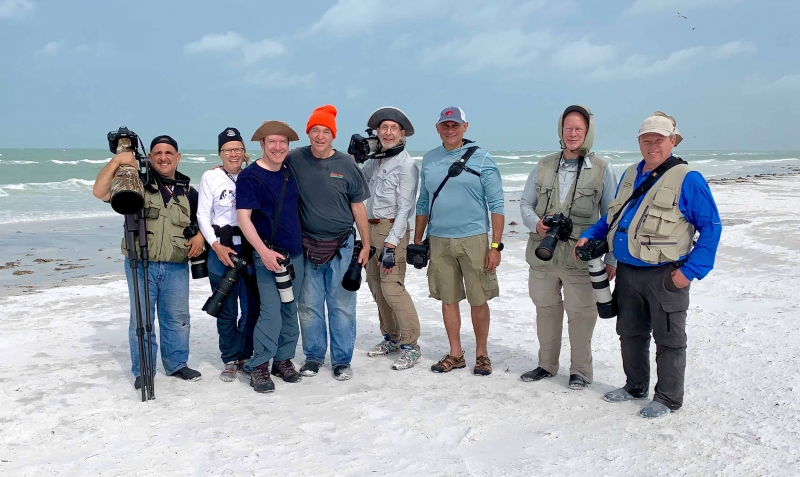
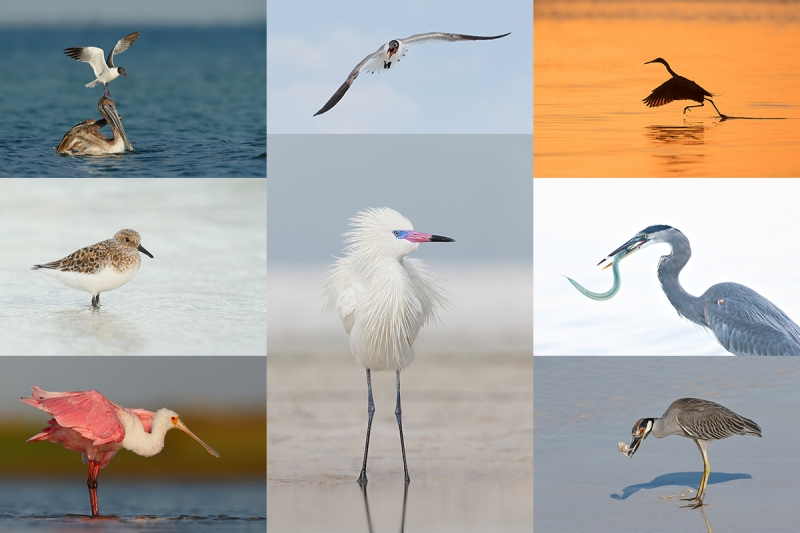
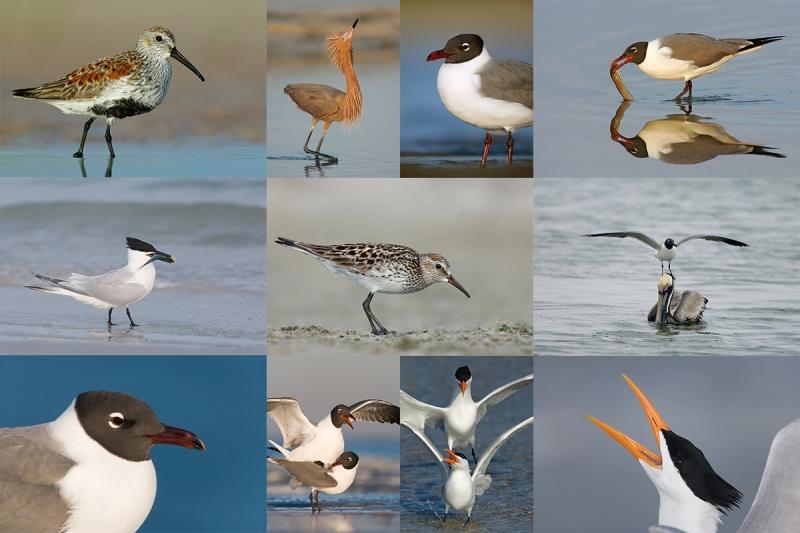
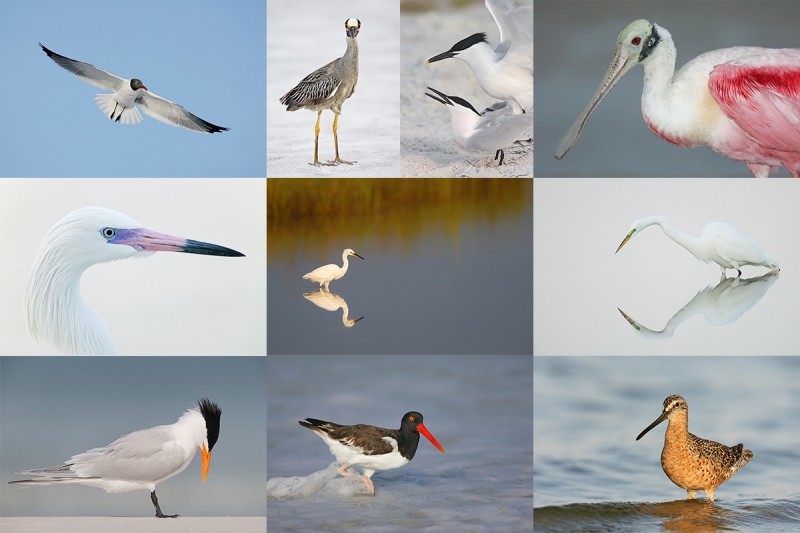
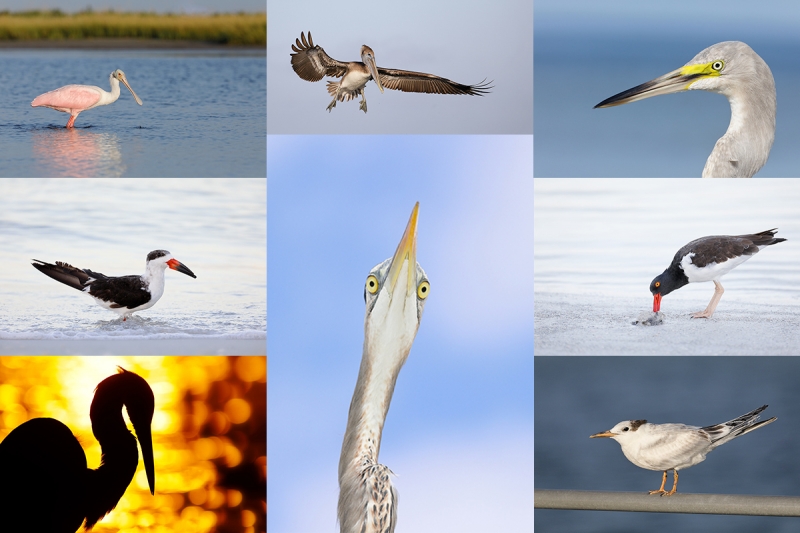

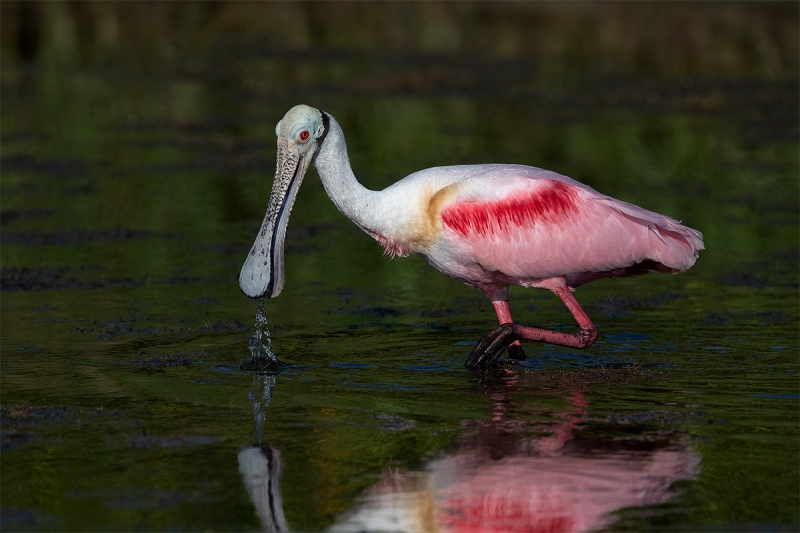
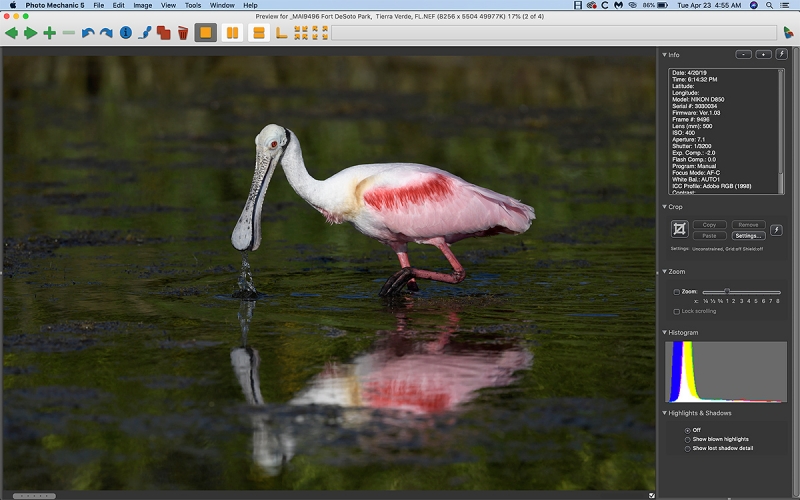
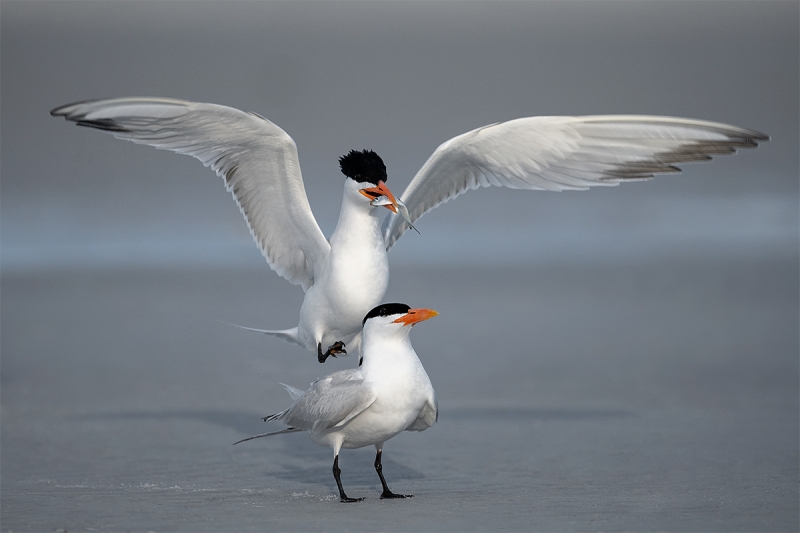
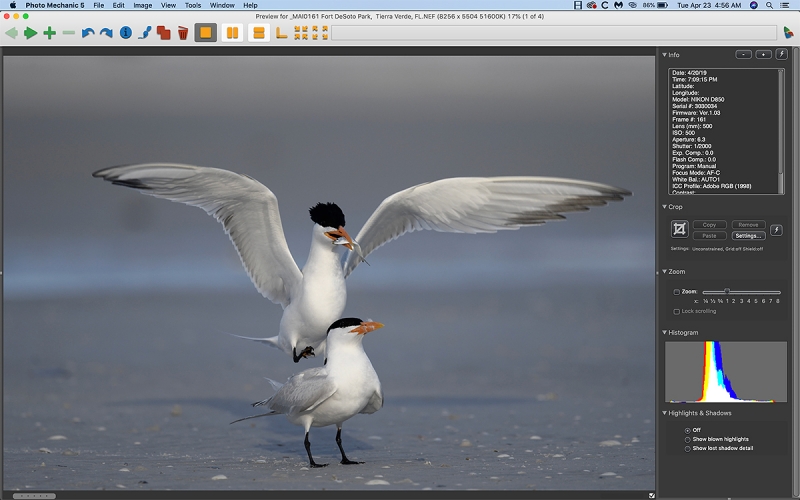














Love the clean-up on the terns picture!
Hi Arthur,
Are you still having issue with your 600E? Or the birds are tamed enough that you don’t need the big 600mm and 500mm is sufficient?
The 600 VR is fine. The problem was with one of my TC-E14s. That said, the 500 PF is light and I rarely if ever use it with a tripod so I have lots of freedom.
with love, artie
Hi Artie
I was there last week and there were a ton of Black Skimmers and four or five Red Knots starting to turn color as were the BB Plovers.These birds plus almost all of what you list above were present. There were several blast-offs and then they would circle and come right back and land in the same spot. May want to tell everyone to bring a TC.
Good Luck
Hi Artie —
Regarding the tern photo cleanup: the shell-free beach looks better and more dreamlike. Perhaps it’s not as realistic, but your website is “Birds as ART” — not “Birds as Photojournalistic Documentation.” The shell-free beach is nicer to look at and more “artistic.”
Steve
Thanks Steve. I agree
with love, artie
I like seeing all the shells. Just makes it more real to me.
Tim — Same situation for me. Mississippi birds are NOT tame. You need to get into position before sunrise, be in a blind, or wear a ghillie suit.
And then I came to the Fort DeSoto IPT and was blown away with Florida birds. Worth the time and money, but then you’ll want to move to Florida.
Rob, glad it’s not just me. I excel at ‘small in the frame’ images!
Yes, the birds in Florida can be silly tame. For small in the frame images, there are two keys: get the bird into a corner of the frame and try them only with lots of attractive habitat.
with love, artie
Thanks for the tip
Hi Artie, how do you get so close to the birds with such a bright hat! Seriously though, getting close enough is one of my biggest challenges, even with a 500mm lens on an APSC body.
Hey Tim,
Where do you live? The birds in FLA are often very tame. That said moving slowly, getting low when possible, and being able to read the bird’s behavior are the skills that you can develop so that you can get closer.
Can you make the Sandbar Secrets IPT?
with love, artie
Yes, definitely have been working on my ‘field craft’. Live in the UK so unfortunately can’t go on an IPT. Have been watching lots of your youtube videos and learning loads. Knowing about sun angle and learning to work in manual mode has improved my photography significantly. I think the birds in my area are wary, and a lot smaller!! It’s warbler season right now. Thanks so much for sharing all your knowledge.
Thanks for your kind words. I still have one slot open on the UK Puffins, Gannets, and Red Kites IPT.
with love, artie